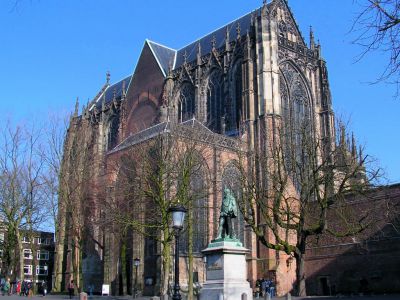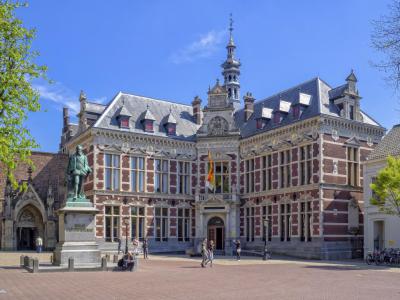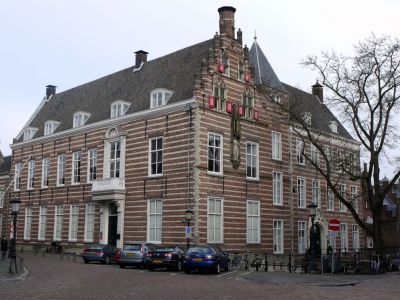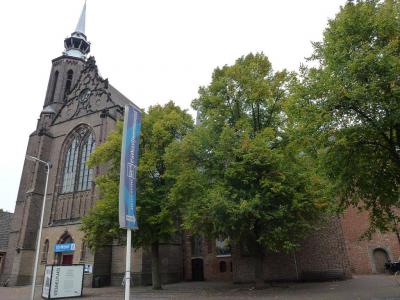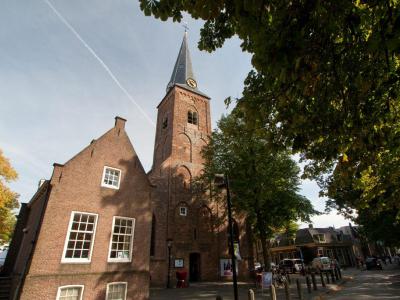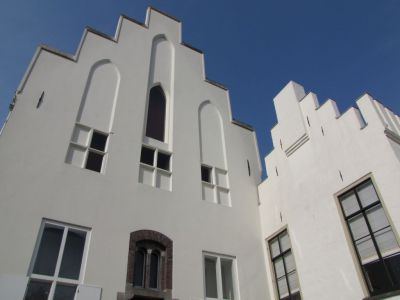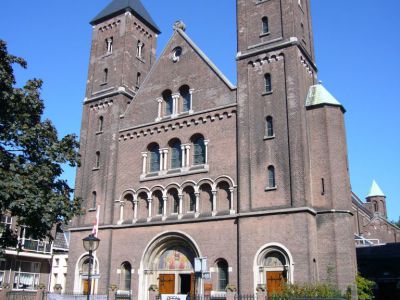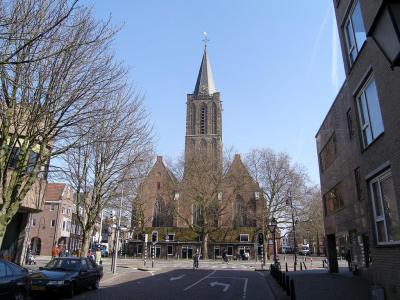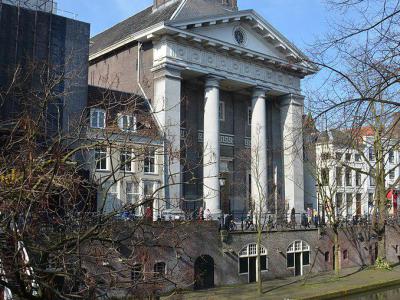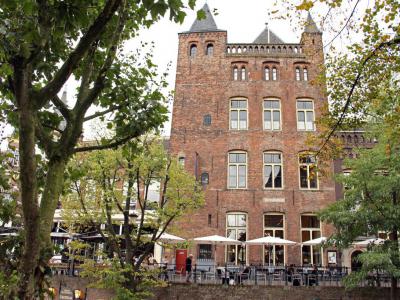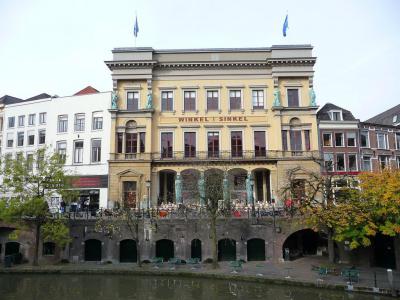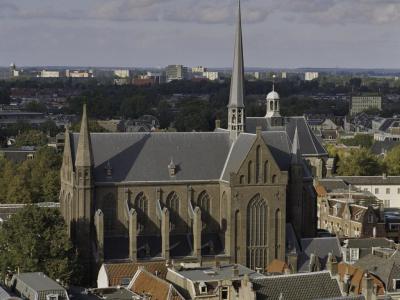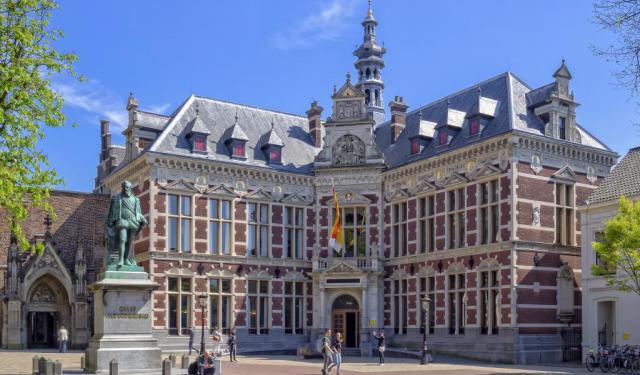
Utrecht's Historical Buildings Walking Tour (Self Guided), Utrecht
Originally founded by the Romans, and once the most important city in the Netherlands, Utrecht boasts a generous share of historically significant structures. The collection of its architectural masterpieces, one of the richest in the country, dates back to the early Middle Ages.
The amazingly well-preserved pieces of historic architecture in Utrecht showcase the trends and movements throughout the centuries, featuring a blend of styles, from Gothic to Baroque to Renaissance to Romantic, some dictated by the Reformation and Dutch wars.
The University of Utrecht, the largest in Holland, has a Hall (Academiegebouw) emerged in the late 19th century from the struggle between different neo-styles.
For years, the Archbishop of Utrecht has been the most important Dutch Catholic leader. The religious theme is duly reflected in the local architectural landmarks, such as Paushuize (Papal House), St. Catharinakathedraal (St. Catherine's Cathedral), Geertekerk (Geerte Church), Sint-Gertrudiskathedraal (St. Gertrude's Cathedral), Jacobikerk (Jacobi Church), Sint-Augustinuskerk (Saint Augustine Church) and Sint-Willibrordkerk (St. Willibrord's Church).
Undoubtedly, however, the most prominent historic building in Utrecht is the Gothic Cathedral of Saint Martin, formally known as Domkerk (Dom Church). As the country's tallest temple, this Cathedral represents a distinctive part of Utrecht's skyline.
Walking around the city makes one feel like entering a large-scale outdoor museum. Indeed, observing all its fascinating buildings from the past is an absolute treat. To experience it firsthand, take this self-guided walk and discover some of Utrecht's best architecture yourself.
The amazingly well-preserved pieces of historic architecture in Utrecht showcase the trends and movements throughout the centuries, featuring a blend of styles, from Gothic to Baroque to Renaissance to Romantic, some dictated by the Reformation and Dutch wars.
The University of Utrecht, the largest in Holland, has a Hall (Academiegebouw) emerged in the late 19th century from the struggle between different neo-styles.
For years, the Archbishop of Utrecht has been the most important Dutch Catholic leader. The religious theme is duly reflected in the local architectural landmarks, such as Paushuize (Papal House), St. Catharinakathedraal (St. Catherine's Cathedral), Geertekerk (Geerte Church), Sint-Gertrudiskathedraal (St. Gertrude's Cathedral), Jacobikerk (Jacobi Church), Sint-Augustinuskerk (Saint Augustine Church) and Sint-Willibrordkerk (St. Willibrord's Church).
Undoubtedly, however, the most prominent historic building in Utrecht is the Gothic Cathedral of Saint Martin, formally known as Domkerk (Dom Church). As the country's tallest temple, this Cathedral represents a distinctive part of Utrecht's skyline.
Walking around the city makes one feel like entering a large-scale outdoor museum. Indeed, observing all its fascinating buildings from the past is an absolute treat. To experience it firsthand, take this self-guided walk and discover some of Utrecht's best architecture yourself.
How it works: Download the app "GPSmyCity: Walks in 1K+ Cities" from Apple App Store or Google Play Store to your mobile phone or tablet. The app turns your mobile device into a personal tour guide and its built-in GPS navigation functions guide you from one tour stop to next. The app works offline, so no data plan is needed when traveling abroad.
Utrecht's Historical Buildings Walking Tour Map
Guide Name: Utrecht's Historical Buildings Walking Tour
Guide Location: Netherlands » Utrecht (See other walking tours in Utrecht)
Guide Type: Self-guided Walking Tour (Sightseeing)
# of Attractions: 12
Tour Duration: 2 Hour(s)
Travel Distance: 3.8 Km or 2.4 Miles
Author: JohnB
Sight(s) Featured in This Guide:
Guide Location: Netherlands » Utrecht (See other walking tours in Utrecht)
Guide Type: Self-guided Walking Tour (Sightseeing)
# of Attractions: 12
Tour Duration: 2 Hour(s)
Travel Distance: 3.8 Km or 2.4 Miles
Author: JohnB
Sight(s) Featured in This Guide:
- Domkerk (Dom Church)
- Academiegebouw (University Hall)
- Paushuize (Pope House)
- St. Catharinakathedraal (St. Catherine's Cathedral)
- Geertekerk (Geerte Church)
- Duitse Huis (Teutonic House)
- Sint-Gertrudiskathedraal (St. Gertrude's Cathedral)
- Jacobikerk (Jacobi Church)
- Sint-Augustinuskerk (Saint Augustine Church)
- Oudaen City Castle
- Winkel van Sinkel Store
- Sint-Willibrordkerk (St. Willibrord's Church)
1) Domkerk (Dom Church) (must see)
Domkerk, as it presently stands, was begun in 1254. It was initially a cathedral of the Roman Catholic Diocese of Utrecht and dedicated to St. Martin, but it has been Protestant since the Reformation in 1580.
This wasn't the first church built here, though. Dom Church has been built on centuries of history. Dom Square was the site of a Roman castellum that guarded a crossing of the river Rhine. The castellum likely included a small stone temple.
During the Middle Ages, the Utrecht area was the cradle of Christianity in the Northern Netherlands. Frankish missionaries built a wood church here in 630, long after the Romans had left.
In 695, Willibrord, an Anglo-Saxon monk, was charged with building a stone church dedicated to St. Martin. At this time, there was also a second church dedicated to St. Salvator. Unfortunately, Normans destroyed the churches here in 857 and the local bishops fled.
Bishop Adalbold built a Romanesque-style church on this site, consecrated in 1023. Sadly, Adalbold's church was mostly destroyed in a nine-day fire in 1253 that affected much of Utrecht.
The Gothic St. Martins Cathedral was started in 1254. However, progress on the cathedral was slow as money for the project was scarce. It wasn't until Jan van Nassau put together a series of measures to secure financing that construction started. That was in 1288.
The 14th and 15th centuries saw several additions and expansions to the church. This included the bell tower, transept, and nave. Still, even after all these years, the money dried up for the projects, and work was done in starts and stops. At this time, the nave connected the church to the tower in one grand cathedral.
A severe storm on August 1, 1674, destroyed the church's nave. The result was the separation of the church and the tower, which has remained to this day. The remains of that original nave stood until 1826.
Over the years, there have been several attempts to rebuild the nave, or at least mark its existence. In 2004 a temporary structure was created using scaffolding.
This wasn't the first church built here, though. Dom Church has been built on centuries of history. Dom Square was the site of a Roman castellum that guarded a crossing of the river Rhine. The castellum likely included a small stone temple.
During the Middle Ages, the Utrecht area was the cradle of Christianity in the Northern Netherlands. Frankish missionaries built a wood church here in 630, long after the Romans had left.
In 695, Willibrord, an Anglo-Saxon monk, was charged with building a stone church dedicated to St. Martin. At this time, there was also a second church dedicated to St. Salvator. Unfortunately, Normans destroyed the churches here in 857 and the local bishops fled.
Bishop Adalbold built a Romanesque-style church on this site, consecrated in 1023. Sadly, Adalbold's church was mostly destroyed in a nine-day fire in 1253 that affected much of Utrecht.
The Gothic St. Martins Cathedral was started in 1254. However, progress on the cathedral was slow as money for the project was scarce. It wasn't until Jan van Nassau put together a series of measures to secure financing that construction started. That was in 1288.
The 14th and 15th centuries saw several additions and expansions to the church. This included the bell tower, transept, and nave. Still, even after all these years, the money dried up for the projects, and work was done in starts and stops. At this time, the nave connected the church to the tower in one grand cathedral.
A severe storm on August 1, 1674, destroyed the church's nave. The result was the separation of the church and the tower, which has remained to this day. The remains of that original nave stood until 1826.
Over the years, there have been several attempts to rebuild the nave, or at least mark its existence. In 2004 a temporary structure was created using scaffolding.
2) Academiegebouw (University Hall)
The Academiegebouw (Academy Building or University Hall) is the main edifice of Utrecht University.
There is a rather remarkable story behind it, illustrating struggle between different neo-styles at the end of the 19th century. The Hall was originally conceived as a gift to the University on the occasion of its 250th anniversary in 1886, but due to a protracted conflict and the unexpected death of one of the architects, Cornelis Vermeijs, the construction could not start until 1891. Followers of neo-Gothic style reckoned the design should have matched the architecture of the nearby Dom Church. However, the city council opted in favor of Neo-Renaissance, as befitting the spirit of humanism associated with the educational institution and alluding to the ancient Greek tradition.
The building's ornaments include medallions on the façade and the bust of Queen Wilhelmina. Inside, the auditoriums boast lavish frescoes. One of them, in room 16, called 'The return of Christ', was made in 1999 to mark the arrival of new millennium. During the 2002 restoration, this room was redesigned to the theme of Masquerade, in reference to the former habit of students to dress up during lustra here, and has subsequently been known as the "Masquerade Hall". Because its original fresco did not match the restoration theme, it was covered with a retaining wall.
The tapestries for the interior were donated in 1936 by the Utrecht University Fund.
On September 18, 2010, the Utrecht Whistleblowers Guild cast a bell in honor of the 375th anniversary of Utrecht University, celebrated in 2011. The bell was named Anna Maria, after Anna Maria van Schurman, the first female student in Utrecht, and hung in the turret above the entrance to the Academy Building.
There is a rather remarkable story behind it, illustrating struggle between different neo-styles at the end of the 19th century. The Hall was originally conceived as a gift to the University on the occasion of its 250th anniversary in 1886, but due to a protracted conflict and the unexpected death of one of the architects, Cornelis Vermeijs, the construction could not start until 1891. Followers of neo-Gothic style reckoned the design should have matched the architecture of the nearby Dom Church. However, the city council opted in favor of Neo-Renaissance, as befitting the spirit of humanism associated with the educational institution and alluding to the ancient Greek tradition.
The building's ornaments include medallions on the façade and the bust of Queen Wilhelmina. Inside, the auditoriums boast lavish frescoes. One of them, in room 16, called 'The return of Christ', was made in 1999 to mark the arrival of new millennium. During the 2002 restoration, this room was redesigned to the theme of Masquerade, in reference to the former habit of students to dress up during lustra here, and has subsequently been known as the "Masquerade Hall". Because its original fresco did not match the restoration theme, it was covered with a retaining wall.
The tapestries for the interior were donated in 1936 by the Utrecht University Fund.
On September 18, 2010, the Utrecht Whistleblowers Guild cast a bell in honor of the 375th anniversary of Utrecht University, celebrated in 2011. The bell was named Anna Maria, after Anna Maria van Schurman, the first female student in Utrecht, and hung in the turret above the entrance to the Academy Building.
Sight description based on Wikipedia.
3) Paushuize (Pope House)
The house at the corner of Kromme Nieuwegracht and Achter Sint Pieter was built for Adriaan Floriszoon Boeyens in 1517. When the house was built, he was in Emperor Charles V of Spain's court, and he wanted to move back to Utrecht one day.
Instead, Adriaan was elected pope in 1522 and died a year later, never to return to the house in Utrecht. Pope Adrian VI was the only Dutch pope.
After the Reformation, the house was purchased by private individuals. Each owner added a few touches to make the house their own, adding facades and Renaissance-style additions. At one point, the house was operated as a restaurant with lodgings.
In its recent history, the house has been used for a wedding venue and meeting space. In addition, the University of Utrecht has used the space from time to time, and in 1985 Pope John Paul II visited here.
Technically, the house is a Renaissance design with Gothic influences. Nevertheless, the interior is beautifully done, with four salons and even a ballroom.
Instead, Adriaan was elected pope in 1522 and died a year later, never to return to the house in Utrecht. Pope Adrian VI was the only Dutch pope.
After the Reformation, the house was purchased by private individuals. Each owner added a few touches to make the house their own, adding facades and Renaissance-style additions. At one point, the house was operated as a restaurant with lodgings.
In its recent history, the house has been used for a wedding venue and meeting space. In addition, the University of Utrecht has used the space from time to time, and in 1985 Pope John Paul II visited here.
Technically, the house is a Renaissance design with Gothic influences. Nevertheless, the interior is beautifully done, with four salons and even a ballroom.
4) St. Catharinakathedraal (St. Catherine's Cathedral)
St. Catharinakathedraal (St. Catherine's Cathedral) in Utrecht is a Roman Catholic temple dedicated to Saint Catherine of Alexandria. It was built as part of the Carmelite friary founded in 1456. After 1529, the work on the building was continued by the Knights Hospitaller order, and was completed only in the mid-16th century.
From 1580 to 1815 it was the home of a Protestant community. In 1815, the temple was returned to the Roman Catholics, first as a garrison church, and then, since 1842, had continued as a parish church.
As of 1853, St. Catherine's has been the seat of the Roman Catholic archdiocese of Utrecht in the capacity of a Cathedral. In 1898, the architect Alfred Tepe commenced major changes to the building. It was extended with the current western nave, copying the old façade, possibly designed by Rombout Keldermans II. A tower, modeled on that of the Kampen town hall, was added in 1900.
Some of the relics of Saint Willibrord, the patron saint of Benelux countries, are held inside the reliquary under the main altar.
For financial reasons, in 2018, the parish board announced plans to shut down the Cathedral. However, on March 2, 2019, that decision was overturned by the Archbishop of Utrecht due to the lack of support from local Catholics, as well as in view of the national significance of Saint Catherine's as the Metropolitan Cathedral of the Dutch Church Province.
From 1580 to 1815 it was the home of a Protestant community. In 1815, the temple was returned to the Roman Catholics, first as a garrison church, and then, since 1842, had continued as a parish church.
As of 1853, St. Catherine's has been the seat of the Roman Catholic archdiocese of Utrecht in the capacity of a Cathedral. In 1898, the architect Alfred Tepe commenced major changes to the building. It was extended with the current western nave, copying the old façade, possibly designed by Rombout Keldermans II. A tower, modeled on that of the Kampen town hall, was added in 1900.
Some of the relics of Saint Willibrord, the patron saint of Benelux countries, are held inside the reliquary under the main altar.
For financial reasons, in 2018, the parish board announced plans to shut down the Cathedral. However, on March 2, 2019, that decision was overturned by the Archbishop of Utrecht due to the lack of support from local Catholics, as well as in view of the national significance of Saint Catherine's as the Metropolitan Cathedral of the Dutch Church Province.
Sight description based on Wikipedia.
5) Geertekerk (Geerte Church)
The Geertekerk is one of the four parish churches in Utrecht that were dedicated, back in the Middle Ages, to Saint Gertrude of Nivelles; it is the smallest and youngest of them. The original church in this area was built outside the city walls, but then moved within the walls between 1248 and 1259.
Since then it had seen many renovations, including the Gothic main tower (probably the oldest preserved element) erected in the 13th century, nave aisles – dating from around 1400; and the choir and transept – from the 14th century. Built of brick, the tower carries two bells: the Ghertrut, weighting 1150 kilos, made in 1477; and the Jesus Maria Johannes (650 kilos), made in 1506.
On April 24, 1793, the notable Dutch mathematician, Laurens Praalder, was interred in the Geertekerk.
Following the Reformation, the Geertekerk was successively used as a Reformed church, a stable, barracks, and a warehouse; then, from 1814 to 1930, it had been used again as a place of worship. In 1855, following the Rhine flood, hundreds of residents of Veenendaal were temporarily accommodated in the building. By the end of the 1940s, the church had found itself in a ruinous state: almost no roof, and the trees growing inside.
After being purchased by the Remonstrant Brotherhood in the 1950s, the building has been completely renovated. Its sober exterior now has a rural vibe to it. The Geertekerk's organ, built in 1803, was moved here in 1956 from the Baptist church in De Rijp.
The exceptionally good acoustics, resulting from the restoration, has made the church a popular venue for concerts. In 2015, further adjustments were made to the interior, including large glass walls. Since 2017, the Geertekerk has also been extensively used for conferences, meetings and other public events.
Since then it had seen many renovations, including the Gothic main tower (probably the oldest preserved element) erected in the 13th century, nave aisles – dating from around 1400; and the choir and transept – from the 14th century. Built of brick, the tower carries two bells: the Ghertrut, weighting 1150 kilos, made in 1477; and the Jesus Maria Johannes (650 kilos), made in 1506.
On April 24, 1793, the notable Dutch mathematician, Laurens Praalder, was interred in the Geertekerk.
Following the Reformation, the Geertekerk was successively used as a Reformed church, a stable, barracks, and a warehouse; then, from 1814 to 1930, it had been used again as a place of worship. In 1855, following the Rhine flood, hundreds of residents of Veenendaal were temporarily accommodated in the building. By the end of the 1940s, the church had found itself in a ruinous state: almost no roof, and the trees growing inside.
After being purchased by the Remonstrant Brotherhood in the 1950s, the building has been completely renovated. Its sober exterior now has a rural vibe to it. The Geertekerk's organ, built in 1803, was moved here in 1956 from the Baptist church in De Rijp.
The exceptionally good acoustics, resulting from the restoration, has made the church a popular venue for concerts. In 2015, further adjustments were made to the interior, including large glass walls. Since 2017, the Geertekerk has also been extensively used for conferences, meetings and other public events.
Sight description based on Wikipedia.
6) Duitse Huis (Teutonic House)
The Duitse Huis (Teutonic House) is a complex of historic buildings in Utrecht. Its older parts once belonged to a monastery of the Bailiwick of Utrecht of the Teutonic Knights, established in 1348.
Back then, the monastery church, large as it was, dominated the area. Most of the land commanders of the order, prominent citizens of Utrecht, were buried there. In 1674 the monastery was badly damaged by a windstorm, and the church, ruined, had to be demolished. One of its bays (out of total seven or eight), measuring over 5.5 meters (18 ft) wide, however, has survived. The sacristy, the main building, the kitchen with outbuildings and the Commander's house have also remained. The "knights room" in the Commander's house was used as a provisional church. In the year 1700, the 14th-century façade was truncated.
Originally Catholic, the order became Protestant during the Reformation.
Napoleon's brother, Louis Bonaparte, bought the property in 1807. After the fall of Napoleon and the restoration of the House of Orange, in 1815 the Bailiwick was revived by royal decree of King William I. During his reign, a very modern (for that time) hospital was added to the complex. Completed in 1823, it had remained military property up until 1990.
The Duitse Huis was registered as a national monument on 20 June 1967.
Eventually, the property was sold back to the Bailiwick of Utrecht, and a major renovation commenced in 1992. Some of the older buildings are once again housing headquarters of the Bailiwick of Utrecht, which is now a charity, and contain an important collection of medieval manuscripts, coins and pictures. Other buildings, including the former hospital, have been converted into a five-star hotel, called the Grand Hotel Karel V.
Back then, the monastery church, large as it was, dominated the area. Most of the land commanders of the order, prominent citizens of Utrecht, were buried there. In 1674 the monastery was badly damaged by a windstorm, and the church, ruined, had to be demolished. One of its bays (out of total seven or eight), measuring over 5.5 meters (18 ft) wide, however, has survived. The sacristy, the main building, the kitchen with outbuildings and the Commander's house have also remained. The "knights room" in the Commander's house was used as a provisional church. In the year 1700, the 14th-century façade was truncated.
Originally Catholic, the order became Protestant during the Reformation.
Napoleon's brother, Louis Bonaparte, bought the property in 1807. After the fall of Napoleon and the restoration of the House of Orange, in 1815 the Bailiwick was revived by royal decree of King William I. During his reign, a very modern (for that time) hospital was added to the complex. Completed in 1823, it had remained military property up until 1990.
The Duitse Huis was registered as a national monument on 20 June 1967.
Eventually, the property was sold back to the Bailiwick of Utrecht, and a major renovation commenced in 1992. Some of the older buildings are once again housing headquarters of the Bailiwick of Utrecht, which is now a charity, and contain an important collection of medieval manuscripts, coins and pictures. Other buildings, including the former hospital, have been converted into a five-star hotel, called the Grand Hotel Karel V.
Sight description based on Wikipedia.
7) Sint-Gertrudiskathedraal (St. Gertrude's Cathedral)
Sint-Gertrudiskathedraal (St. Gertrude's Cathedral) in Utrecht is the seat of local Archbishop and the mother church of the Old Catholic Church of the Netherlands.
The current building was constructed between 1912 and 1914, designed by E.G. Wentinck in Neo-Romanesque style, echoing St. Mary's Church, which formerly stood very close by, on Mariaplaats. Its predecessor, called St. Gertrude's Chapel (Dutch: Gertrudiskapel), has been preserved, and is currently attached to the Cathedral. The chapel was built in 1634, as part of a medieval house, and was used as a clandestine temple for the members of the Roman Catholic parish of the Geertekerk (original St. Gertrude's Church which is now in the possession of the Remonstrants).
In the Old Catholic Schism in 1723, the parish joined the Old Catholic Church, as well as James Parish and the Parish of Maria Minor. Subsequently, Gertrude's Chapel was elevated to the status of cathedral church of the Old Catholics.
The once hidden church is one of the best-preserved architectural monuments in the Netherlands. Its current appearance was mainly achieved during renovation in 1697, during which the house floors were broken through to create galleries. Most recently, from 1991 to 1993, the church had once again undergone restoration.
In the altar there are more than 1700 relics held in hundreds of containers. Among them is said to be a fragment of the rib of St. Willibrord.
The current building was constructed between 1912 and 1914, designed by E.G. Wentinck in Neo-Romanesque style, echoing St. Mary's Church, which formerly stood very close by, on Mariaplaats. Its predecessor, called St. Gertrude's Chapel (Dutch: Gertrudiskapel), has been preserved, and is currently attached to the Cathedral. The chapel was built in 1634, as part of a medieval house, and was used as a clandestine temple for the members of the Roman Catholic parish of the Geertekerk (original St. Gertrude's Church which is now in the possession of the Remonstrants).
In the Old Catholic Schism in 1723, the parish joined the Old Catholic Church, as well as James Parish and the Parish of Maria Minor. Subsequently, Gertrude's Chapel was elevated to the status of cathedral church of the Old Catholics.
The once hidden church is one of the best-preserved architectural monuments in the Netherlands. Its current appearance was mainly achieved during renovation in 1697, during which the house floors were broken through to create galleries. Most recently, from 1991 to 1993, the church had once again undergone restoration.
In the altar there are more than 1700 relics held in hundreds of containers. Among them is said to be a fragment of the rib of St. Willibrord.
Sight description based on Wikipedia.
8) Jacobikerk (Jacobi Church)
The Jacobi Church (Jacobikerk) is a landmark Protestant church in Utrecht. The building is located on the St Jacobsstraat, named for its patron saint St. James the Greater. The church is one of the medieval parish churches of Utrecht, along with the Buurkerk, the Nicolaïkerk and the Geertekerk.
Today it is known as the starting place for Dutch pilgrims on their way to Santiago de Compostella along the Way of St. James. The Dutch Confraternity of St. James is located around the corner on the St. Jacobskerkhof.
The current gothic church dates from the end of the 13th century, but was expanded in the 14th and 15th centuries.
The church is still used on Sundays as a church but can be rented it out the rest of the week for other functions, including weddings and concerts, but also various cultural initiatives of the city or the local university.
Today it is known as the starting place for Dutch pilgrims on their way to Santiago de Compostella along the Way of St. James. The Dutch Confraternity of St. James is located around the corner on the St. Jacobskerkhof.
The current gothic church dates from the end of the 13th century, but was expanded in the 14th and 15th centuries.
The church is still used on Sundays as a church but can be rented it out the rest of the week for other functions, including weddings and concerts, but also various cultural initiatives of the city or the local university.
Sight description based on Wikipedia.
9) Sint-Augustinuskerk (Saint Augustine Church)
Sint-Augustinuskerk (Saint Augustine's Church) is a Roman Catholic temple in Utrecht, dedicated to Augustine van Hippo.
Designed in the Classical Revival style by Karel Georg Zocher, the building was erected in 1839-1840, being the first large Catholic church built in the city since the Dutch Reformation and the restoration of religious freedom. Among other things, Saint Augustine's is distinguished by its front, overlooking the canal, with the enormous Doric columns topped by a pediment and an airy turret (40m high). Behind it is the hall church, which is spanned by a stuccoed wooden barrel vault.
The tranquil interior is an undivided neo-Baroque space with richly adorned stucco and Classical capitals on the columns and pilasters. The main altar was made in 1857 by Prosper Venneman from Ghent. The organ dates from 1844 and was built by the Utrecht organ builder HD Lindsen. The Gothic-style belfry contains four bells.
As of May 2018, there has been a discussion underway whether this church, relatively small in size, may replace the current Saint Catherine's Cathedral, destined for deconsecration for being too large for the drastically reduced in recent decades Catholic practice in Utrecht. Still, no exact date for that has been specified yet.
Designed in the Classical Revival style by Karel Georg Zocher, the building was erected in 1839-1840, being the first large Catholic church built in the city since the Dutch Reformation and the restoration of religious freedom. Among other things, Saint Augustine's is distinguished by its front, overlooking the canal, with the enormous Doric columns topped by a pediment and an airy turret (40m high). Behind it is the hall church, which is spanned by a stuccoed wooden barrel vault.
The tranquil interior is an undivided neo-Baroque space with richly adorned stucco and Classical capitals on the columns and pilasters. The main altar was made in 1857 by Prosper Venneman from Ghent. The organ dates from 1844 and was built by the Utrecht organ builder HD Lindsen. The Gothic-style belfry contains four bells.
As of May 2018, there has been a discussion underway whether this church, relatively small in size, may replace the current Saint Catherine's Cathedral, destined for deconsecration for being too large for the drastically reduced in recent decades Catholic practice in Utrecht. Still, no exact date for that has been specified yet.
Sight description based on Wikipedia.
10) Oudaen City Castle
Oudaen is a fortified medieval castle located at number 99 on the Oudegracht in Utrecht, and is one of the city's most important architectural monuments. Back in the 12th-14th centuries, the wealthy noble families built large properties on the Oudegracht, of which Oudaen is now best preserved in its medieval appearance.
First built in the 1270s, as a family home, like the other "city castles" of that period it comprises a large, imposing main building and a considerably smaller side one that was easier to heat and subsequently more suitable to live in.
Oudaen was originally owned by the Zoudenbalch family, one of the most prominent families in Utrecht. In 1395, it came into the possession of another wealthy local family, the Oudaens, and has kept their name ever since.
During the siege of Vredenburg Castle in 1576-1577, the house, and particularly its rear façade, suffered severe damage. A number of bullet holes left in the wall serve as a reminder of that time. During the negotiations for the Treaty of Utrecht in 1713, one of the key players in the diplomatic process, the French envoy Melchior de Polignac, was accommodated here.
In 1758 the house lost its private function when the deacon of the Reformed Church bought it and converted it to a retirement home; Oudaen had served in this capacity until 1965.
During a 19th-century modernization, the pointed Gothic arches above windows on the front façade were removed and the battlements along the rampart replaced by a balustrade. The battlements on the side and rear facades were preserved.
Over the centuries, Oudaen has had many tenants and been used for different purposes. As of 1986, following a thorough restoration, it has been housing a catering facility.
First built in the 1270s, as a family home, like the other "city castles" of that period it comprises a large, imposing main building and a considerably smaller side one that was easier to heat and subsequently more suitable to live in.
Oudaen was originally owned by the Zoudenbalch family, one of the most prominent families in Utrecht. In 1395, it came into the possession of another wealthy local family, the Oudaens, and has kept their name ever since.
During the siege of Vredenburg Castle in 1576-1577, the house, and particularly its rear façade, suffered severe damage. A number of bullet holes left in the wall serve as a reminder of that time. During the negotiations for the Treaty of Utrecht in 1713, one of the key players in the diplomatic process, the French envoy Melchior de Polignac, was accommodated here.
In 1758 the house lost its private function when the deacon of the Reformed Church bought it and converted it to a retirement home; Oudaen had served in this capacity until 1965.
During a 19th-century modernization, the pointed Gothic arches above windows on the front façade were removed and the battlements along the rampart replaced by a balustrade. The battlements on the side and rear facades were preserved.
Over the centuries, Oudaen has had many tenants and been used for different purposes. As of 1986, following a thorough restoration, it has been housing a catering facility.
Sight description based on Wikipedia.
11) Winkel van Sinkel Store
Set among the numerous medieval houses along the Oudegracht canal is the Winkel van Sinkel building. It was originally built as a store, between 1837 and 1839, after Anton Sinkel, the owner, moved his business from Amsterdam to Utrecht.
The store was opened on May 6, 1839. Although it was primarily a drapery store without self-service, it is considered to be the first department store in the Netherlands. At some point, Winkel van Sinkel even became a general term for shops where everything was for sale.
The Rotterdam architect, Pieter Adams, designed the building in a late-Baroque style. The idea to decorate it with caryatids (sculpted female figure-columns) belongs to Sinkel. The four cast-iron statues were made in England and thence mockingly referred to as the “British whores”.
During their transportation, which happened to be by a barge, an accident happened. While lifting one of the statues, the upper part of the crane at the wharf broke off and fell into the water, along with the load. To this day, the site where the crane stood, in front of the building, is still marked.
The story does not tell, however, how the heavy statue finally got out of the water. In addition to the caryatids, another four cast-iron figures – symbolizing Commerce, Prudence, Seafaring, and Hope – have been placed on the façade as well.
The Sinkel company sold the property in 1898 and ceased to exist in 1912.
Today, the building is known as "Cultural Culinary Department Store". In addition to its function as a grand café-restaurant, it hosts evening dance club on weekends, with a tango matinee every second Sunday of the month, and a salsa party on all other Sundays. Other cultural activities also regularly take place, including the so-called Cultural Sundays.
The store was opened on May 6, 1839. Although it was primarily a drapery store without self-service, it is considered to be the first department store in the Netherlands. At some point, Winkel van Sinkel even became a general term for shops where everything was for sale.
The Rotterdam architect, Pieter Adams, designed the building in a late-Baroque style. The idea to decorate it with caryatids (sculpted female figure-columns) belongs to Sinkel. The four cast-iron statues were made in England and thence mockingly referred to as the “British whores”.
During their transportation, which happened to be by a barge, an accident happened. While lifting one of the statues, the upper part of the crane at the wharf broke off and fell into the water, along with the load. To this day, the site where the crane stood, in front of the building, is still marked.
The story does not tell, however, how the heavy statue finally got out of the water. In addition to the caryatids, another four cast-iron figures – symbolizing Commerce, Prudence, Seafaring, and Hope – have been placed on the façade as well.
The Sinkel company sold the property in 1898 and ceased to exist in 1912.
Today, the building is known as "Cultural Culinary Department Store". In addition to its function as a grand café-restaurant, it hosts evening dance club on weekends, with a tango matinee every second Sunday of the month, and a salsa party on all other Sundays. Other cultural activities also regularly take place, including the so-called Cultural Sundays.
Sight description based on Wikipedia.
12) Sint-Willibrordkerk (St. Willibrord's Church)
Sint-Willibrordkerk is a Roman Catholic church dedicated to Saint Willibrord. Located in the historic centre of Utrecht, near the Dom Church, Saint Willibrord's has been one of the city's hidden treasures and a Rijksmonument (national heritage site) since 1976. A finely preserved example of the Utrecht Styl, which is a conservative variant of Gothic Revival in The Netherlands, focused on the late Gothic period, the Lower Rhine Gothic style in particular, the temple was built from 1875 to 1877 under the direction of a group of priests.
The church was designed by architect Alfred Tepe. Because it is surrounded by houses, the architect chose to build it extra tall, yet short enough, with high windows. The sober brick exterior of the church is a great contrast to the elaborate and colourful interior, which wasn't completed until 1891.
Many artists from the St. Bernulphus Guild had worked together to decorate the building. Almost every wall inside is painted. Alongside the colourful frescoes there are numerous wood carvings and stained glass windows depicting the life of St. Willibrord.
The most important part of the church, the choir, is the most extensively decorated. Central to this is the symbolism of the Holy Sacrament. Another distinctive part of the interior is a well-known organ, built by Maarschalkerweerd.
In the 1960s, the diocese of Utrecht wanted to sell and demolish the building. Lay people and father Winand Kotte A.A., bought the property and kept it intact. Today, to maintain the church, it is often rented out for classical concerts during the week.
The Sunday Masses take place at 10:30am. Masses are also held every Friday at 19:00, and Saturday at 11:00.
The church was designed by architect Alfred Tepe. Because it is surrounded by houses, the architect chose to build it extra tall, yet short enough, with high windows. The sober brick exterior of the church is a great contrast to the elaborate and colourful interior, which wasn't completed until 1891.
Many artists from the St. Bernulphus Guild had worked together to decorate the building. Almost every wall inside is painted. Alongside the colourful frescoes there are numerous wood carvings and stained glass windows depicting the life of St. Willibrord.
The most important part of the church, the choir, is the most extensively decorated. Central to this is the symbolism of the Holy Sacrament. Another distinctive part of the interior is a well-known organ, built by Maarschalkerweerd.
In the 1960s, the diocese of Utrecht wanted to sell and demolish the building. Lay people and father Winand Kotte A.A., bought the property and kept it intact. Today, to maintain the church, it is often rented out for classical concerts during the week.
The Sunday Masses take place at 10:30am. Masses are also held every Friday at 19:00, and Saturday at 11:00.
Sight description based on Wikipedia.
Walking Tours in Utrecht, Netherlands
Create Your Own Walk in Utrecht
Creating your own self-guided walk in Utrecht is easy and fun. Choose the city attractions that you want to see and a walk route map will be created just for you. You can even set your hotel as the start point of the walk.
Utrecht Introduction Walking Tour
The earliest settlers to the area now called Utrecht likely arrived millennia ago during the Stone Age. While there are also signs of inhabitation during the Bronze Age, scholars today credit the Romans with building what became the town.
They set up a castellum around the year 50 AD, a fort right at a crossing point on the river Rhine. The fortress marked Rome's northernmost point in... view more
Tour Duration: 1 Hour(s)
Travel Distance: 1.6 Km or 1 Miles
They set up a castellum around the year 50 AD, a fort right at a crossing point on the river Rhine. The fortress marked Rome's northernmost point in... view more
Tour Duration: 1 Hour(s)
Travel Distance: 1.6 Km or 1 Miles
The Most Popular Cities
/ view all
